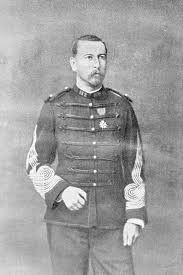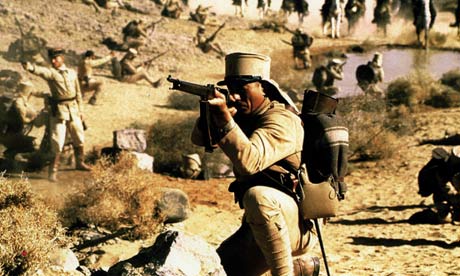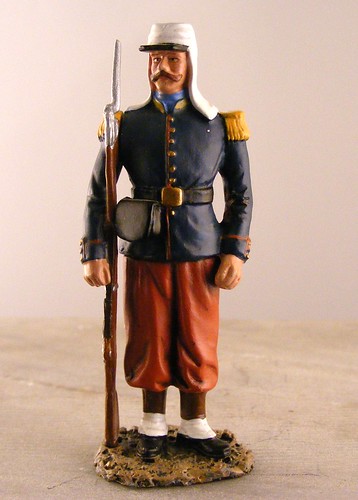
I found 'Legionnaire' for $10 on a rack labelled "Movies that should
never have been made!". I had never seen 'Legionnaire', but on the same
rack was the Arnie classic 'Conan the Barbarian'. I decided that
whoever was running the store obviously didn't know what they were
talking about - I'm sure Arnie will forgive them - and so I picked up
'Legionnaire'. If I had known it had a lot more of Jean-Claude Van
Damme acting rather than Van Damme beating the **** out of bad guys, I
probably would have avoided it. Good thing I gave it a go, as it wasactually pretty good.If you liked the Van damme film then these FFL above are perfect for recreating the soldiers portrayed in the film . The one thing wrong is the neck guard as Wren states in his books on the legion that they were considered unmanly and never worn.
portrayed in the film . The one thing wrong is the neck guard as Wren states in his books on the legion that they were considered unmanly and never worn.
Beyond its reputation of the French Foreign Legion as an elite unit often embroiled in serious fighting, its recruitment practices have also led to a romantic view of it being a place for a wronged man to leave behind his old life to start a new one, yet also being full of scoundrels and men escaping justice. This view of the legion is common in literature, and has been used for dramatic effect in many films, not the least of which are the several versions of Beau Geste.
wronged man to leave behind his old life to start a new one, yet also being full of scoundrels and men escaping justice. This view of the legion is common in literature, and has been used for dramatic effect in many films, not the least of which are the several versions of Beau Geste.
never have been made!". I had never seen 'Legionnaire', but on the same
rack was the Arnie classic 'Conan the Barbarian'. I decided that

whoever was running the store obviously didn't know what they were
talking about - I'm sure Arnie will forgive them - and so I picked up
'Legionnaire'. If I had known it had a lot more of Jean-Claude Van

Damme acting rather than Van Damme beating the **** out of bad guys, I
probably would have avoided it. Good thing I gave it a go, as it wasactually pretty good.If you liked the Van damme film then these FFL above are perfect for recreating the soldiers
 portrayed in the film . The one thing wrong is the neck guard as Wren states in his books on the legion that they were considered unmanly and never worn.
portrayed in the film . The one thing wrong is the neck guard as Wren states in his books on the legion that they were considered unmanly and never worn.
Beyond its reputation of the French Foreign Legion as an elite unit often embroiled in serious fighting, its recruitment practices have also led to a romantic view of it being a place for a
 wronged man to leave behind his old life to start a new one, yet also being full of scoundrels and men escaping justice. This view of the legion is common in literature, and has been used for dramatic effect in many films, not the least of which are the several versions of Beau Geste.
wronged man to leave behind his old life to start a new one, yet also being full of scoundrels and men escaping justice. This view of the legion is common in literature, and has been used for dramatic effect in many films, not the least of which are the several versions of Beau Geste.
There is a French song originally created by Marie Dubas in 1936 but now mainly identified with Édith Piaf, called "Mon légionnaire", about a woman's longing for an embittered Legionnaire with whom she had a brief affair and who refused to tell her his name. The song was reprised by Serge Gainsbourg in the 1980s, the male voice singing the lyrics made famous by Piaf. The new version of "Mon Légionnaire" was a hit on French dancefloors. askari
askari
 askari
askariAnother of Piaf's songs was "Le Fanion de la Légion" (The Flag of the Legion), describing the heroic defence by the garrison in a small Legion outpost attacked by Saharan tribes. Both songs were written by Raymond Asso, a Foreign Legion veteran who was Piaf's lover in the late 1930s, with music by Marguerite Monnot.

The Legion adopted still another Édith Piaf song as their own, "Non, je ne regrette rien" (No, I regret nothing), during the 1950s when members of the Legion were accused of being implicated in a failed coup d'etat during the Algerian War  askari
askari
Today it is still a popular Legion "chant" sung when on parade, adapting it to their unique marching cadence of 88 steps to the minute.
 askari
askariToday it is still a popular Legion "chant" sung when on parade, adapting it to their unique marching cadence of 88 steps to the minute.

]Frank Sinatra performed a song called "French Foreign Legion" about joining up if a girl does not marry him.

The indie-rock band The Decemberists wrote a song called "The Legionnaire's Lament" on their 2002 album Castaways and Cutouts. The song describes the homesickness of a French legionnaire on duty on the Algerian-Morroccan border in the early 1900s.
The Legion's 1st Battalion (Lieutenant-Colonel Donnier) was sent to Tonkin in the autumn of 1883, during the period of undeclared hostilities that preceded the Sino-French War (August 1884 to April 1885), and formed part of the attack column that stormed the western gate of Son Tay on 16 December. The 2nd and 3rd infantry battalions (chef de bataillon Diguet and Lieutenant-Colonel Schoeffer) were also deployed to Tonkin shortly afterwards, and were present in all the major campaigns of the Sino-French War. Two Legion companies led the defence at the celebrated Siege of Tuyen Quang (24 November 1884 to 3 March 1885).In January 1885 the Legion's 4th Battalion (chef de bataillon Vitalis) was deployed to the French bridgehead at Keelung (Jilong) in Formosa (Taiwan),
The 2nd and 3rd infantry battalions (chef de bataillon Diguet and Lieutenant-Colonel Schoeffer) were also deployed to Tonkin shortly afterwards, and were present in all the major campaigns of the Sino-French War. Two Legion companies led the defence at the celebrated Siege of Tuyen Quang (24 November 1884 to 3 March 1885).In January 1885 the Legion's 4th Battalion (chef de bataillon Vitalis) was deployed to the French bridgehead at Keelung (Jilong) in Formosa (Taiwan), where it took part in the later battles of the Keelung Campaign. The battalion played an important role in Colonel Jacques Duchesne's offensive in March 1885 that captured the key Chinese positions of La Table and Fort Bamboo and disengaged Keelung.
where it took part in the later battles of the Keelung Campaign. The battalion played an important role in Colonel Jacques Duchesne's offensive in March 1885 that captured the key Chinese positions of La Table and Fort Bamboo and disengaged Keelung.
 The 2nd and 3rd infantry battalions (chef de bataillon Diguet and Lieutenant-Colonel Schoeffer) were also deployed to Tonkin shortly afterwards, and were present in all the major campaigns of the Sino-French War. Two Legion companies led the defence at the celebrated Siege of Tuyen Quang (24 November 1884 to 3 March 1885).In January 1885 the Legion's 4th Battalion (chef de bataillon Vitalis) was deployed to the French bridgehead at Keelung (Jilong) in Formosa (Taiwan),
The 2nd and 3rd infantry battalions (chef de bataillon Diguet and Lieutenant-Colonel Schoeffer) were also deployed to Tonkin shortly afterwards, and were present in all the major campaigns of the Sino-French War. Two Legion companies led the defence at the celebrated Siege of Tuyen Quang (24 November 1884 to 3 March 1885).In January 1885 the Legion's 4th Battalion (chef de bataillon Vitalis) was deployed to the French bridgehead at Keelung (Jilong) in Formosa (Taiwan), where it took part in the later battles of the Keelung Campaign. The battalion played an important role in Colonel Jacques Duchesne's offensive in March 1885 that captured the key Chinese positions of La Table and Fort Bamboo and disengaged Keelung.
where it took part in the later battles of the Keelung Campaign. The battalion played an important role in Colonel Jacques Duchesne's offensive in March 1885 that captured the key Chinese positions of La Table and Fort Bamboo and disengaged Keelung.
The Siege of Tuyen Quang was an important confrontation between the French and the Chinese armies in Tonkin (northern Vietnam) during the Sino-French War (August 1884–April 1885).
A French garrison of 630 men, including two companies of the French Foreign Legion, successfully defended the French post of Tuyen Quang against vastly-superior Chinese forces in a four-month siege from 24 November 1884 to 3 March 1885. 'Tuyen Quang 1885' remains one of the Legion's proudest battle honours.

The French installed a post at Tuyen Quang in June 1884, in the wake of their capture of Hung Hoa and Thai Nguyen. Tuyen Quang, an isolated settlement on the Clear River, was the most westerly French outpost in Tonkin, and was 80 kilometres from the nearest French post at Phu Doan. During the summer and autumn of 1884 it was garrisoned by two companies of the 1st Battalion, 1st Foreign Legion Regiment (Captains Chmitelin and Broussier), under the command of chef de bataillon Frauger. 

The outbreak of the Sino-French War on 23 August 1884 exposed the post to attack by Tang Jingsong's Yunnan Army and Liu Yongfu’s Black Flags. Supply difficulties delayed the Chinese concentration around Tuyen Quang, but advance elements of the Yunnan Army began to harass the post in October 1884, and Frauger's garrison had to fight off a number of nuisance attacks by the Chinese. Malaria had also taken a heavy toll of Frauger's men, and by the end of October 170 men out of the garrison's total strength of 550 men were unfit for duty.

In November 1884 General Louis Brière de l'Isle, the commander of the Tonkin Expeditionary Corps, took steps to resupply and reinforce Hung Hoa, Thai Nguyen and Tuyen Quang. On 19 November a column making for Tuyen Quang under the command of Lieutenant-Colonel Jacques Duchesne was ambushed in the Yu Oc gorge by the Black Flags but was able to fight its way through to the beleaguered post. 

Frauger and his men were relieved, and replaced by a fresh garrison of 400 legionnaires and 160 Tonkinese riflemen under the command of chef de bataillon Marc-Edmond Dominé of the 2nd African Light Infantry Battalion. Duchesne left Tuyen Quang on 23 November, and on the following day Dominé formally declared Tuyen Quang to be in a state of siege. The siege of Tuyen Quang would last for just over four months.
Tang Jingsong (1841–1903), the commander of the Yunnan Army in the siege of Tuyen Quang

Chef de bataillon Marc-Edmond Dominé (1848–1920), the commander of the Tuyen Quang garnison

The new garrison of Tuyen Quang, just under 630 men strong, consisted of two companies of the 1st Battalion, 1st Foreign Legion Regiment (Captains de Borelli and Moulinay) under the overall command of Captain Cattelin, a company of Tonkinese riflemen under the command of the French marine infantry officer Captain Dia, a scratch battery of six light cannon (Lieutenant Derappe) and small engineering and field hospital detachments. The garrison was supported by the Farcy gunboat Mitrailleuse (enseigne de vaisseau Senes), at anchor in the Clear River close to the French post.

The Chinese army besieging Tuyen Quang was under the overall command of Tang Jingsong (Tang Ching-sung, 唐景崧). The Chinese forces consisted of 9,000 men of the Yunnan Army and 3,000 men of Liu Yongfu's Black Flag Army. The Yunnan Army forces were divided into two divisions, commanded by Tang's lieutenants Ding Huai (Ting Huai, 丁槐) and He Xiulin (Ho Hsiu-lin, 何秀林).

The fortress of Tuyen QuangThe French fortress at Tuyen Quang was typical of the small, remote outposts of France’s colonial empire. Lying on the western bank of the Clear River next to the Tonkinese village of Tuyen Quang, it consisted of a square masonry citadel, each of whose walls was 300 yards long.  charbens
charbens
Inside the citadel’s perimeter were several barrack buildings, a lake and a large earthen mound in the shape of a sugar loaf. This hill, which looked just like a natural formation, took the place at Tuyen Quang of the tower traditionally found in Tonkinese citadels.
Inside the citadel’s perimeter were several barrack buildings, a lake and a large earthen mound in the shape of a sugar loaf. This hill, which looked just like a natural formation, took the place at Tuyen Quang of the tower traditionally found in Tonkinese citadels.
The citadel was overlooked by a number of wooded hills, which the Chinese were bound to occupy. There was little Dominé could do to stop Chinese snipers from using these hills to fire down into the citadel, but he could at least delay the main enemy assault by building outworks to keep the Chinese at a respectable distance from the main perimeter. Accordingly, he had a blockhouse built on a hill 300 metres to the south of the citadel, which was occupied by a strong force of legionnaires. He also built a separate defensive perimeter to the southeast of Tuyen
Accordingly, he had a blockhouse built on a hill 300 metres to the south of the citadel, which was occupied by a strong force of legionnaires. He also built a separate defensive perimeter to the southeast of Tuyen  Quang which was occupied by Captain Dia and his company of Tonkinese riflemen. This position, centred on a fortifed pagoda on t
Quang which was occupied by Captain Dia and his company of Tonkinese riflemen. This position, centred on a fortifed pagoda on t
 Accordingly, he had a blockhouse built on a hill 300 metres to the south of the citadel, which was occupied by a strong force of legionnaires. He also built a separate defensive perimeter to the southeast of Tuyen
Accordingly, he had a blockhouse built on a hill 300 metres to the south of the citadel, which was occupied by a strong force of legionnaires. He also built a separate defensive perimeter to the southeast of Tuyen  Quang which was occupied by Captain Dia and his company of Tonkinese riflemen. This position, centred on a fortifed pagoda on t
Quang which was occupied by Captain Dia and his company of Tonkinese riflemen. This position, centred on a fortifed pagoda on tIn December 1883, during a review of the 2nd Legion Battalion on the eve of its departure for Tonkin to take part in the Bac Ninh campaign, General François de Négrier pronounced a famous mot: Vous, légionnaires, vous êtes soldats pour mourir, et
General François de Négrier pronounced a famous mot: Vous, légionnaires, vous êtes soldats pour mourir, et je vous envoie où l’on meurt! ('You, Legionnaires, you are soldiers in order to die, and I'm sending you to where one dies!')
je vous envoie où l’on meurt! ('You, Legionnaires, you are soldiers in order to die, and I'm sending you to where one dies!')
 General François de Négrier pronounced a famous mot: Vous, légionnaires, vous êtes soldats pour mourir, et
General François de Négrier pronounced a famous mot: Vous, légionnaires, vous êtes soldats pour mourir, et je vous envoie où l’on meurt! ('You, Legionnaires, you are soldiers in order to die, and I'm sending you to where one dies!')
je vous envoie où l’on meurt! ('You, Legionnaires, you are soldiers in order to die, and I'm sending you to where one dies!')In 1959 Chad Valley released the board game Sahara Patrol.
 This was a game for two players: who either took the part of the Foreign Legion or the Arabs, and fought for control of forts in the Sahara. A year later in 1960 the English card game manufacturer Pepys produced the Foreign Legion Card Game.
This was a game for two players: who either took the part of the Foreign Legion or the Arabs, and fought for control of forts in the Sahara. A year later in 1960 the English card game manufacturer Pepys produced the Foreign Legion Card Game.
Radiohead's song "Cuttooth," a b-side to 2001 single "Knives Out," features the lyric "I would lead the wall paper life/ or run away to the Foreign Legion."



No comments:
Post a Comment